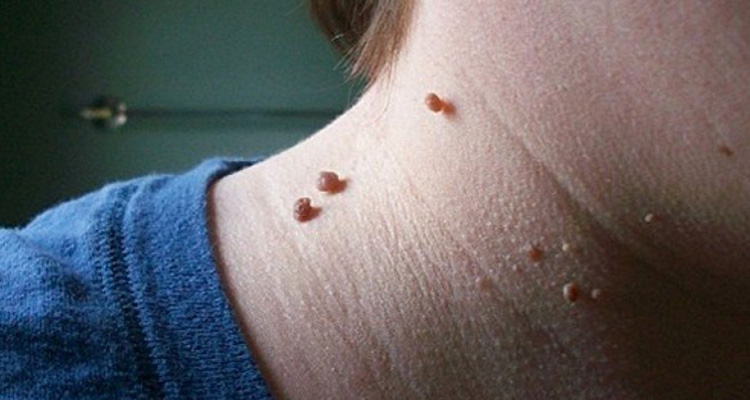FIBROMAS

Definition: Fibromas are benign (non-cancerous) tumors that are composed of fibrous or connective tissue. They can grow in all organs, arising from mesenchyme tissue (a type of loose connective tissue). The term “fibroblastic” or “fibromatous” is used to describe tumors like fibroma. The term fibrosarcoma is reserved for malignant (cancerous) tumors. [1]
Other Names: Fibroid tumors or fibroids.
Types of Fibromas
There are two common fibromas seen on the skin, and these are the hard fibromas (dermatofibroma) and the soft fibroma (skin tag).
Hard Fibroma
The hard fibroma (fibroma durum) consists of many fibres and few cells. [2] If seen on the skin it is known as a dermatofibroma and a special form is the keloid.
What it looks like – A dermatofibroma is a round, brownish to purple growth commonly found on the legs and arms. Dermatofibromas contain scar tissue and feel like hard lumps in the skin. [2]
Cause – It is unknown why people grow dermatofibromas. Some may be caused by insect bites or other disruptions of the skin.
Treatment – Dermatofibromas are best ignored if possible. If cancer is questionable, a piece may be removed for tissue analysis. Dermatofibromas can be removed surgically but since they are deep, this usually leaves a scar. [2] When a dermatofibroma gets in the way of shaving or is irritated by clothing, it can be flattened by freezing with liquid nitrogen, and then allowing the skin to fall off. Liquid nitrogen freezing destroys only the upper part of the growth and so after several years it may again become noticeable and will need to be treated again with liquid nitrogen.
Soft Fibroma
The soft fibroma (fibroma molle) or fibroma with a shaft (also called acrochordon, skin tag, and fibroma pendulans) [5] consists of many loosely connected cells and less fibroid tissue then the hard dermatofibroma. These usually appear at the neck, armpits or groins but can be elsewhere like the eyelid.
What it looks like – A skin tag is a small, brown or flesh-colored flap of skin that is usually narrow at its base. [5]
Causes – There is no known reason for the appearance of skin tags, but they occur most frequently at sites where the skin is rubbed by clothing or other body parts. They tend to occur in body creases, especially those with a hot and moist environment. They do not cause pain unless they become twisted, irritated, or inflamed. [5]
Treatment – It is usually not medically necessary to treat skin tags however, if they are unsightly or annoying they can be removed. Methods of removing skin tags include the following:
- cutting them off with a sterile scalpel or scissors (should be done by a physician only)
- cauterizing the tag (burning with a special heated needle)
- freezing the tag off with liquid nitrogen
- laser surgery (usually for very severe tags) [5]
Other types of Fibromas
This list contains several of the common types of fibromas, but there are many that are not listed here.
Angiofibroma – The fibroma cavernosum or angiofibroma, consists of many often dilated vessels. These are vasoactive tumors occurring almost exclusively in adolescent males. [3]
Cystic fibroma (fibroma cysticum) – has central softening or dilated lymphatic vessels. [1]
Myxofibroma (fibroma myxomatodes) – is produced by liquefaction of the underlying soft tissue. [1]
Cemento-ossifying fibroma – is hard and fibrous and most frequently seen in the jaw or mouth. This is sometimes in connection with a fracture or another type of injury, which results in the fibroma. [1]
Treatment
Benign fibromas can be removed if cosmetically this is requested by the patient, but usually can just be left alone. A physician should examine the fibroma and determine whether it may be malignant. If there is any question as to whether it may be cancer-related, it should be removed in a brief outpatient procedure at the clinic. [2]
Ovarian fibroma
Ovarian fibromas appear in the sex cord-stromal tumor group of ovarian neoplasms. [4] Ovary fibromas are most frequent during middle age and usually present as firm and a gathering if fibers that are white or tan in color. On microscopic examination, there are intersecting bundles of spindle cells producing collagen that create the ovarian fibroma. There may be thecomatous areas (fibrothecoma). [4] The presence of an ovarian fibroma can cause ovarian torsion (twisting of the ovary) in some cases. This will often require surgery, and can be a life threatening condition.
References:
http://www.nlm.nih.gov/cgi/mesh/2009/MB_cgi?field=uid&term=D005350
http://www.skinsite.com/info_dermatofibromas.htm
Ovarian Fibroma. http://www.medcyclopaedia.com/library/topics/volume_iv_2/o/ovarian_fibroma.aspx


